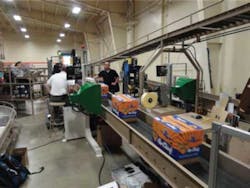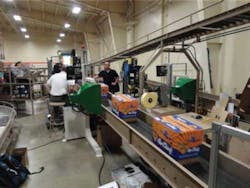FACTORY AUTOMATION: Package inspection system tracks and traces fresh produce
Approximately six billion cases of produce are shipped in the United States each year and, on rare occasions, contaminated produce finds its way into the supply chain. To identify the source of contaminated produce quickly and accurately, the Canadian Produce Marketing Association (Ottawa, Ontario, Canada;www.cpma), Produce Marketing Association (Newark, DE; www.pma.com), and United Fresh Produce Association Washington, DC; www.unitedfresh.org) formed the Produce Traceability Initiative (PTI; www.producetraceability.org) to help produce companies and their buyers to move toward achieving complete food chain traceability of their products by establishing a common framework and nomenclature for product identification.
The PTI is based on a 14-digit Global Trade Item Number (GTIN) that is assigned to every possible type of case based on the commodity, subtype, size, count, area of origin, grower, and packer. The GTIN along with the lot number is provided in human readable form and encoded in a barcode on each case. Each subsequent handler then needs to read and store the GTIN and lot number from each case of produce received. In case of a problem, this makes it possible to quickly trace goods through each handling stage to their source.
But the produce industry faces challenges in achieving PTI compliance. Packers typically handle many different types of packages that are mixed together on their production lines. Often customers have their own case design and the produce is packed into many different customers' cases in the packing plant. The workers in the packing line normally stamp the specifications such as the commodity, subtype, size and count on the side of the case with a rubber stamp. The number one PTI compliance challenge for the packer is to automatically read the rubber stamp and identify the product associated with the package design and then automatically generate a label that contains this information in both human readable and 2D barcode format and affix it to the side of the case.
Sun Pacific (Pasadena, CA;www.sunpacific.com), the largest grower, packer and marketer of citrus fruits in the United States, recently overcame this challenge by implementing the HarvestMark PTI from YottaMark (Redwood City, CA; www.harvestmark.com) in conjunction with the VR-3000 vision inspection system from Saber Engineering (Auburn, CA; www.sabereng.com) in fifteen of its packing houses (see figure).
In operation, the self-contained VR-3000 system distinguishes between the different types of packages and stamps and recognizes and verifies attributes such as type of shipping container, commodity and size at speeds of up to 3,100 boxes per hour. This information is then stored on the HarvestMark database for processing. Trace-back, trace-forward and production data is hosted on the HarvestMark system, delivering supply chain reporting and enabling on-demand traceability anywhere in the supply chain.
Saber Engineering's PC-based VR-3000 uses an Ethernet-based camera to capture images of the packages and stamps, I/O interface to a PLC-based reject mechanism and Ethernet output to a printer and the HarvestMark system.
To recognize package designs and stamps, the system uses VisionPro vision tools from Cognex (Natick, MA;www.cognex.com) to recognize package designs and stamps. Using the PatMax part and feature location tool, the system is first trained to learn an object's geometry and then looks for similar geometries in captured images. The result is an improvement over normalized correlation-based pattern matching techniques since the system can identify objects regardless of angle, size, and variations in illumination. In operation, the VR-3000 can identify boxes and stamps with a read rate of better than 99.5%.
Since packers are continually adding different packages and stamps to their line, the VR-3000 allows operators to train the system to recognize new case designs and stamps. By placing a box in front of the camera and pressing "learn" in the HMI, an image of the box then appears on the screen along with three windows superimposed on the box representing the area inspected by the PatMax inspection tools. The operator then adjusts the tools so that features that distinguish the case design and the stamp that indicates the subtype, size and count of the produce are identified.
Vision Systems Articles Archives

